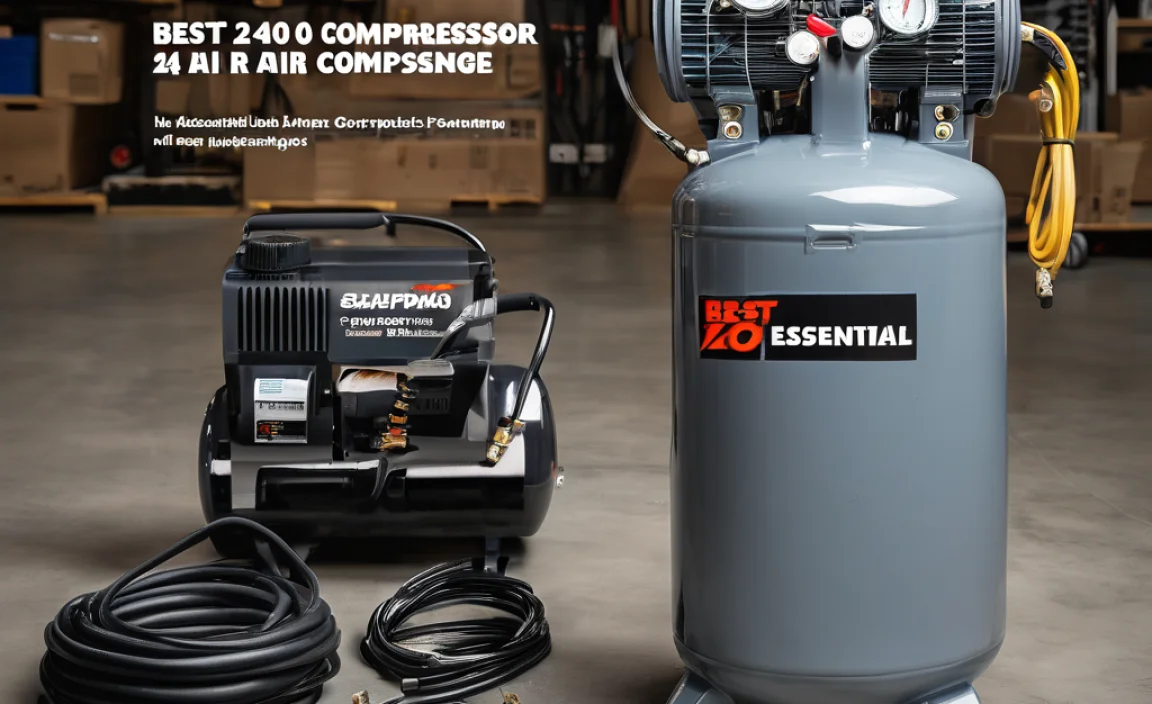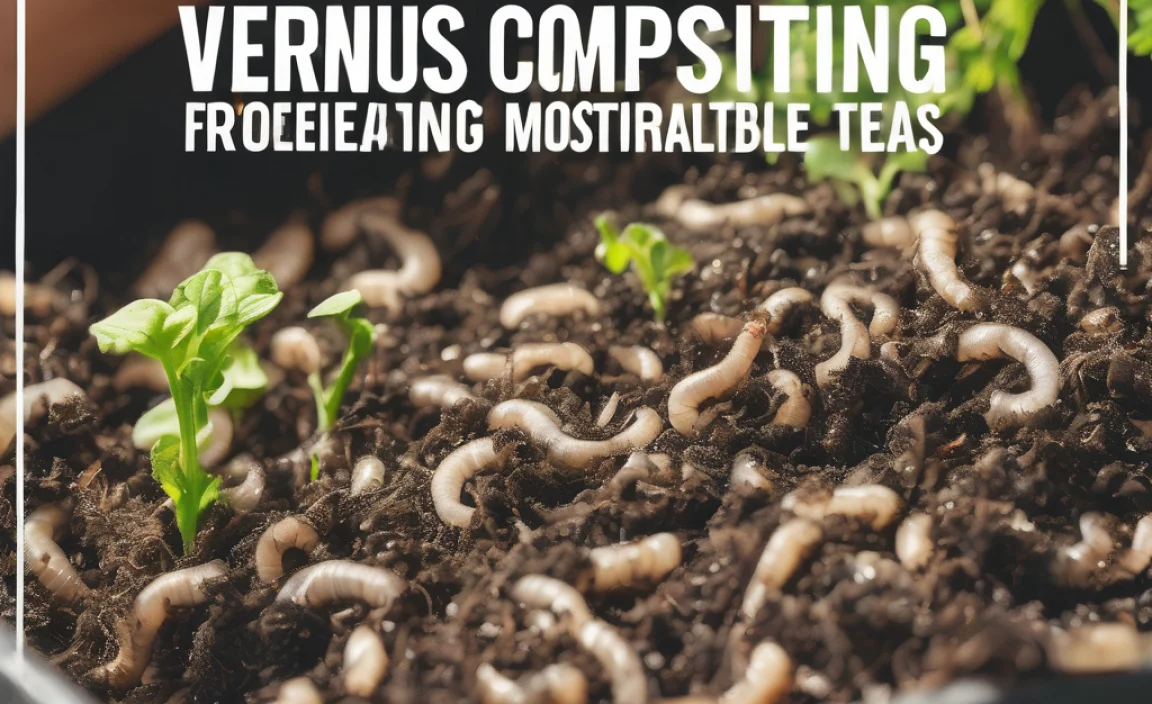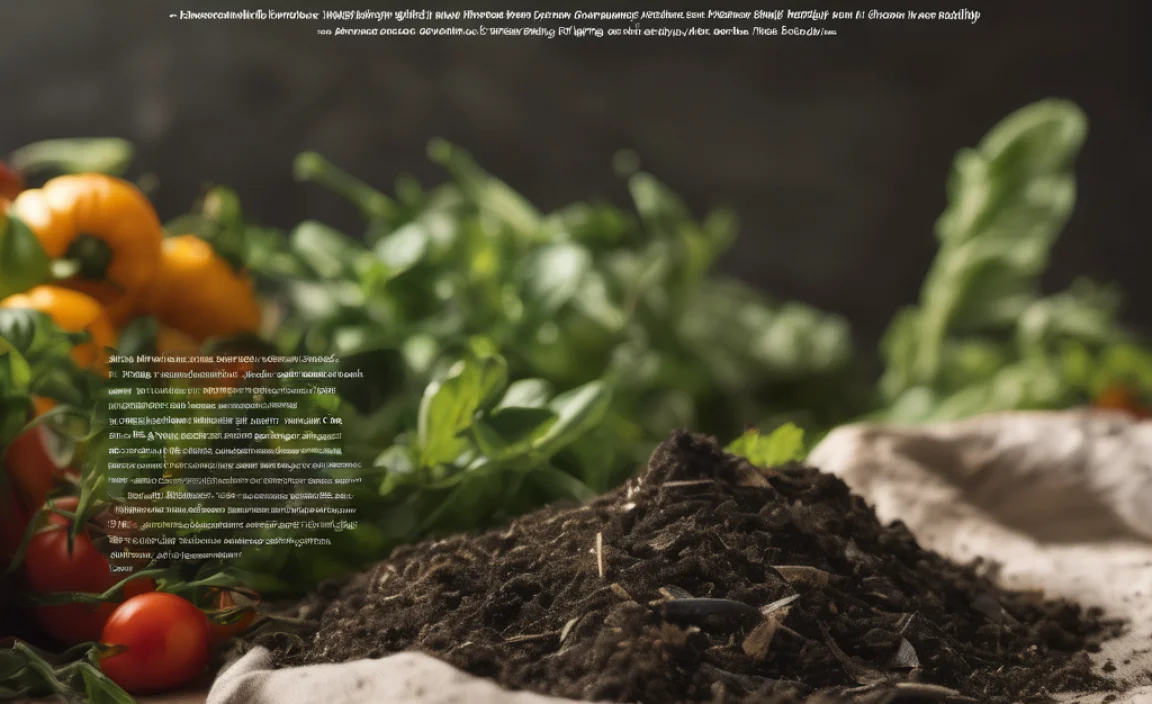Ever feel overwhelmed by kitchen scraps and yard waste? You want to help the planet and have great soil for your garden, but dealing with compost seems messy and time-consuming. Buying a ready-made compost tumbler can be pricey, and frankly, some of them aren’t that sturdy.
What if you could build your own, perfectly suited to your needs, and save money too? This guide will show you how to create a genius, effortless compost tumbler that makes composting a breeze. Get ready to turn waste into garden gold!
Why Build Your Own Compost Tumbler?
Composting is fantastic for your garden and the environment. It reduces landfill waste and creates nutrient-rich soil. Compost tumblers are a popular choice because they speed up the composting process and keep pests away. However, store-bought tumblers can be expensive. Plus, they often come in one size, which might not fit your space or the amount of waste you produce. Building your own compost tumbler is a super smart way to get a compost solution that’s just right for you, often at a fraction of the cost.
When you build it yourself, you have total control:
- Cost-Effective: Save a significant amount compared to buying a new one.
- Customizable Size: Make it big enough for your kitchen scraps and garden trimmings, or small enough for a balcony.
- Sturdy Construction: Choose materials that will last for years.
- Satisfying Project: There’s a great sense of accomplishment in building something useful.
- Environmentally Friendly: Plus, you’re upcycling materials!
Choosing Your DIY Compost Tumbler Design
There are a few popular designs for DIY compost tumblers, and the best one for you depends on your skills, available materials, and how much effort you want to put in. We’ll focus on a super popular and rather effortless design: the single-chamber tumbler using a barrel or bin.
This design typically involves a large barrel or bin that can rotate. It’s genius because the tumbling action mixes your compost materials, introduces air, and keeps moisture evenly distributed, all of which are key to fast, effective composting. It’s also relatively simple to build, making it perfect for beginners.
Here’s a quick look at common DIY tumbler styles:
Single Drum Tumbler: This is what we’ll focus on. Uses one large drum that spins on an axle or on a frame. Great for beginners and efficient.
Dual Chamber Tumbler: Has two sections. You fill one, let it compost, then move it to the second chamber to finish while you start filling the first again. More complex to build but allows for continuous composting.
Stationary Bin with Aeration: Not a tumbler, but a DIY bin designed for good airflow. Simpler to build than a tumbler but requires manual turning with a compost fork.
For a truly “genius & effortless” DIY experience, the single drum tumbler is your champion.
Materials and Tools You’ll Need
Don’t worry, we’re keeping this simple! You won’t need a whole workshop for this project. The goal is to make it as accessible as possible for any DIYer.
Essential Materials:
- The Drum/Bin: This is your main compost holder. Look for sturdy, food-grade plastic barrels. A 55-gallon barrel is a popular choice. You can often find these secondhand from food or beverage companies (just make sure they are thoroughly cleaned if previously used for chemicals).
- Lumber for the Stand: You’ll need some sturdy wood to build a frame for your tumbler to sit on and rotate. 4x4s and 2x4s are common choices. Weather-resistant wood like cedar or pressure-treated lumber is ideal.
- Hardware:
- Large Bolt or Rod (for axle): A sturdy metal rod or a thick bolt (around 1/2″ to 3/4″ diameter) that will go through the center of your drum for it to rotate on.
- Washers and Nuts: To secure the axle and allow for smooth spinning.
- Wood Screws: Weather-resistant deck screws are a good bet.
- Hinges and Latch: For creating a door to add and remove compost.
- Optional (but recommended):
- Small Vent Screen: To cover ventilation holes and keep bugs out.
- Sturdy Pipe/Brackets: If you’re not using a central axle, you might need a way for the drum to rest and spin on top of the frame.
Tools You’ll Likely Use:
- Drill: For making holes for your axle and screws.
- Drill Bits: Various sizes, including a spade bit or hole saw if you need larger holes for the axle.
- Saw: A hand saw or circular saw to cut lumber for the stand.
- Measuring Tape: For accurate cuts and assembly.
- Pencil or Marker: To mark your cuts and drill points.
- Screwdriver or Drill with Screwdriver Bits: For fastening screws.
- Wrench or Socket Set: To tighten nuts and bolts.
- Safety Glasses and Gloves: Always important for DIY projects!
- Optional: Jigsaw: If you need to cut out a door opening in the drum.
Finding a food-grade barrel can sometimes be the trickiest part. Check online marketplaces or local industrial areas. If you can’t find a barrel, a large plastic trash bin with a secure lid can sometimes work, but a barrel is generally more robust for continuous tumbling.
Looking for the right tools? Reputable hardware stores or online retailers like The Home Depot or Lowe’s are great places to find everything you need.
Step-by-Step: Building Your Genius DIY Compost Tumbler
Let’s get building! Follow these straightforward steps to create your own effortless compost tumbler. Remember, safety first – wear your safety glasses and gloves!
Step 1: Prepare Your Drum
If you’re using a recycled barrel, give it a really good clean. Wash it thoroughly with soap and water, especially if it held anything other than food products. Rinse it out completely and let it dry.
Create the Axle Holes: Decide where your axle will go. You want it to go through the center of the drum from side to side, allowing the drum to spin freely. Mark the exact center on both the total opposite sides of the drum. Using your drill with an appropriate-sized bit or hole saw, carefully drill holes on these marks. The hole should be just large enough for your bolt or rod to pass through snugly.
Step 2: Prepare the Door for Adding Compost
You’ll need a way to get your compostables in and finished compost out. You can cut a rectangular opening on one side of the drum. This opening should be large enough to easily add materials and scoop out compost later.
Use a jigsaw or a sturdy utility knife for this. Be precise. Once cut, you’ll reattach the piece you cut out using hinges and a simple latch so you can open and close it securely.
Tip: Make sure the cut edges are as smooth as possible. You can sand them down a bit.
Step 3: Build the Lumber Frame
This is where your lumber comes in. You’re building a sturdy stand that will hold the drum and allow it to rotate. A basic frame looks like two end pieces connected by crossbeams. The distance between the end pieces should be slightly wider than your drum.
Design Idea: Think of two ‘A’ frames or simple rectangular supports connected at the top and bottom. The drum will rest in the cradle created at the top of these supports by your chosen rotation method.
Axle Method: If using a central axle, you’ll need to drill holes in the top of your frame’s upright supports. The holes should align with the holes in your drum and be large enough for the axle rod to pass through. The drum will then sit on this axle.
Alternative Rotation Method: If you’re not using a central axle, you might build a frame with U-shaped brackets or a simple cradle at the top where the drum can sit and be manually rolled by hand. This often requires the drum to have a flat side or a reinforced base to rest on.
Use your screws to assemble the frame securely. Make sure it’s level and stable!
Step 4: Assemble the Tumbler and Frame
If using the axle method: Slide your prepared axle rod through one side of the drum, then through the hole in the first frame support. Add a washer and nut (loosely if you want to test spin now, or securely if you prefer to do that later). Then, slide the axle through the second frame support. Finally, slide it through the other side of the drum. Secure with washers and nuts on the outside. Ensure the drum can spin freely on the axle. Adjust nuts as needed.
If using the cradle/bracket method: Place your drum into the cradle or brackets on your frame. Ensure it sits securely and can be easily rotated by hand.
Step 5: Secure the Door
Attach the door piece you cut out back onto the drum using your sturdy hinges. Make sure it swings open and closed easily. Install a simple latch mechanism (a hook-and-eye or a sliding bolt works great) to keep the door securely shut while the compost is working.
Step 6: Add Ventilation (Optional but Recommended)
Good airflow is crucial for composting. You can drill a few extra small holes around the drum to help with aeration. If you do this, consider covering these holes with a piece of fine mesh screen (secured with adhesive or small screws) to prevent flies and other critters from getting in. You can find metal or plastic vent screens at most hardware stores. Consider placing these on all sides.
Step 7: Test and Place Your Tumbler
Give your new compost tumbler a good spin! Does it rotate smoothly? Is the door secure? Is the frame stable?
Find a good spot for it. Ideally, it should be in a sunny location to help heat the compost, but some shade is okay too, especially in very hot climates. Make sure it’s accessible for you to add scraps and easy to turn.
A great tip for ventilation comes from the University of California Statewide Integrated Pest Management Program, which highlights that good airflow is essential for “hot composting” and reducing odors.
Tips for Effortless Composting with Your DIY Tumbler
Now that you’ve built your genius compost tumbler, let’s talk about using it the effortless way. The key to quick, compost is balance!
What to Compost: Greens and Browns
Your compost needs a good mix of “greens” (nitrogen-rich) and “browns” (carbon-rich). Aim for a ratio of about 1 part greens to 2 or 3 parts browns.
Greens (Nitrogen):
- Fruit and vegetable scraps
- Coffee grounds and tea bags
- Grass clippings (in thin layers)
- Plant trimmings
- Eggshells
Browns (Carbon):
- Dry leaves
- Shredded cardboard and newspaper (avoid glossy paper)
- Wood chips or sawdust (in moderation)
- Straw or hay
- Paper towels and napkins (if not soiled with grease or chemicals)
What to Avoid:
- Meat, fish, and dairy products (can attract pests and cause odors)
- Oily or greasy foods
- Diseased plants
- Weeds that have gone to seed
- Pet waste (from cats or dogs)
Getting the Balance Right
Start by adding a layer of browns to the bottom of your empty tumbler. Then, add your kitchen scraps (greens) as you collect them. Whenever you add greens, try to add a good amount of browns on top to cover them. This helps prevent odors and discourages pests.
Moisture Management
Your compost should be damp, like a wrung-out sponge. If it’s too dry, add a little water. If it’s too wet, add more browns. The tumbling action helps distribute moisture, but it’s still important to check.
Tumbling Frequency
This is the “effortless” part! For your tumbler, aim to give it a good spin every few days. 5-10 full rotations are usually sufficient. The more you turn it, the faster the composting process. Regular turning mixes the materials, aerates the pile, and speeds up decomposition.
The Environmental Protection Agency (EPA) recommends regular turning for effective composting, and a tumbler makes this task much easier!
Composting Time
With a well-balanced, frequently turned compost tumbler, you can see finished compost in as little as 4-8 weeks! If your tumbler is in a sunnier spot and you’re diligent with turning, you might even get results faster. Cooler weather or less frequent turning can extend this time.
Troubleshooting Common Issues
Even with a genius DIY tumbler, you might run into a few minor hiccups. Here’s how to fix them easily:
1. It Smells Bad (Rotten Egg or Ammonia Smell)
Cause: Too many “greens” (nitrogen) and not enough “browns” (carbon), leading to anaerobic conditions (lack of air).
Solution: This is the most common issue! Tumble your compost more frequently and add a generous amount of dry, brown materials like shredded cardboard, dry leaves, or sawdust. Leave the door open for a few hours (if safe from pests) to let it air out before closing again.
2. It’s Not Heating Up or Composting is Slow
Cause: Lack of moisture, not enough “greens,” too many “browns,” or insufficient turning.
Solution: Check the moisture level – it should feel like a damp sponge. If dry, add water and tumble. Ensure you have a good mix of greens and browns. If it’s mostly browns, add more kitchen scraps. Turn the pile more often.
3. There are Pests (Flies, etc.)
Cause: Exposed food scraps, materials that attract pests (no meat/dairy!), or holes that are too large.
Solution: Always cover fresh kitchen scraps with a layer of browns. Make sure you’re not adding prohibited items like meat or dairy. Check your tumbler for any large gaps or holes; cover them with screen mesh. Ensure the door latch is secure.
4. Materials Look Too Wet and Soggy
Cause: Too much moisture, often from excess kitchen scraps or rain getting in.
Solution: Add plenty of dry brown materials (shredded cardboard, leaves, straw). Tumble well to help distribute the drying effect. If the weather is very wet, you might need to cover your tumbler partially to prevent excess rain from soaking the contents.
Remember, composting is a natural process. A little patience and adjustment go a long way!
Advantages of a DIY Compost Tumbler
Building your own compost tumbler isn’t just about saving money; it comes with some fantastic perks that make it a truly genius move for any gardener or eco-conscious homeowner.
Cost Savings
This is often the biggest driver. While lumber and hardware have a cost, it’s almost always significantly less than buying a commercially produced tumbler, especially for larger, more robust models. You can often source used barrels or even scrap wood, further reducing expenses.
Customization
You get to design it to your exact needs. Want a slimmer model for a small patio? A larger one for a big garden? You can adjust dimensions and features to fit your space and your composting volume. You can also choose the materials that best suit your climate and desired lifespan of the tumbler.
For instance, if you live in a very wet climate, you might build a slightly taller frame to keep it out of puddles, or even add a small roof overhang over the door.
Durability and Sturdiness
When you build it yourself, you control the quality of materials. You can opt for thicker lumber, corrosion-resistant screws, and a robust barrel that will stand up to the elements and the daily use of tumbling. This often results in a tumbler that lasts much longer than cheaper store-bought versions.

I am passionate about home engineering. I specialize in designing, installing, and maintaining heating, ventilation, and air conditioning systems. My goal is to help people stay comfortable in their homes all year long.



